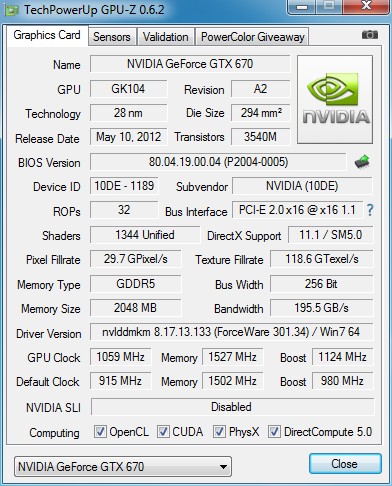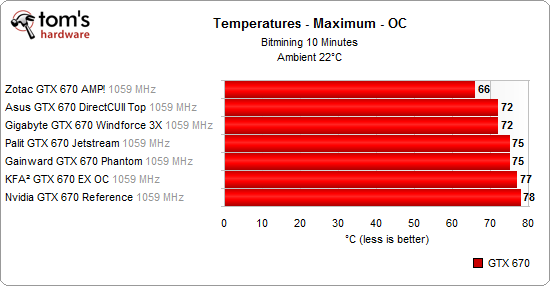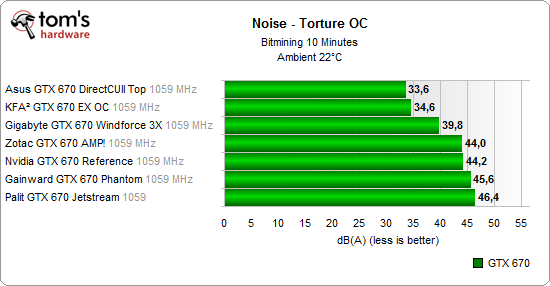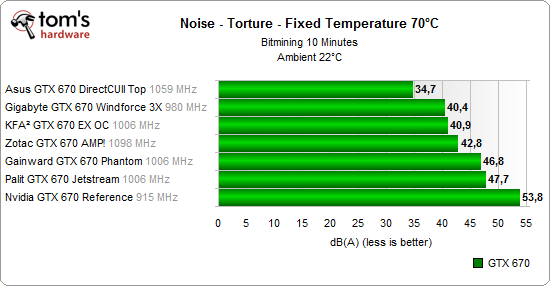Seven GeForce GTX 670 Cards, Benchmarked And Reviewed
We have seven GeForce GTX 670 cards. Which is fastest? Which is quietest? Each one swaggers onto the scene ready to prove its worth to your wallet. We emphasize thermals, acoustics, and design in this many-way shoot-out based on Nvidia's capable GK104.
Sound Level And Temperature: Overclocked
Normalizing Clocks To Test Cooling Performance
We set all cards to employ a 1059 MHz GPU clock (which the reference board handles at a load temp under 80°C) and a 1527 MHz memory frequency. All of the boards ran at that combination of clock rates without crashing throughout testing.
A look at the thermal and sound level measurements at this clock rate make it clear that our critiques on Zotac's card were premature. All of the other cards have to work hard in this environment, while the AMP! Edition board gets to relax a bit.
To our surprise, Nvidia's reference card can keep up with the pack. It even pulls in front of two three-slot competitors. The high bar of 78°C is no cause for concern; this is an intentional stress test.
Cooling Them Down to 70°C
Our next comparison involves measuring acoustics when we dial in a fan speed able to hold each card at 70°C, a temperature chosen for its long-term attractiveness in heavy workloads like Bitcoin mining. We're using each card at its factory clock rate because overclocked reference cards simply cannot hold 70°C.
Zotac's AMP! Edition board shines here. It can even spin slower to maintain 70°C at this lower clock rate. But the real winners are Asus and Gigabyte. Meanwhile, our Galaxy/KFA² board again annoys us with its high-frequency chirping.
Get Tom's Hardware's best news and in-depth reviews, straight to your inbox.
Current page: Sound Level And Temperature: Overclocked
Prev Page Sound Level And Temperature: Stock Settings Next Page Sound Level Comparison, With Video
Igor Wallossek wrote a wide variety of hardware articles for Tom's Hardware, with a strong focus on technical analysis and in-depth reviews. His contributions have spanned a broad spectrum of PC components, including GPUs, CPUs, workstations, and PC builds. His insightful articles provide readers with detailed knowledge to make informed decisions in the ever-evolving tech landscape
-
user 18 On the Gigabyte card's page:Reply
During the course of our testing, we effortlessly set this card to run at 1059 MHz, so we're not sure why Gigabyte held back so much. During testing, we overclocked this card to 1059 MHz quite easily, so we are somewhat surprised by the conservative factory overclock.
This seems to be saying the same thing twice. Error, or am I missing something? -
FormatC Reply
The roundup was published in German on May 22, 2012:10445301 said:Where is the msi gtx 670 power edition?
http://www.tomshardware.de/Nvidia-Geforce-GTX-670-Roundup,testberichte-241027.html
Sorry, but at this time (and 4 weeks later too) MSI was unable to deliver one of this cards. When MSI starts so late with this cards, then this is not our fault. ;)
-
user 18 Also, the second chart on the 'Sound Level and Temperature: Overclocked' page is missing the 'Mhz' label on the speed for the Palit card. It should read '1059 Mhz', while it reads only '1059'.Reply -
LonelyMan I'd like to see one for the 680s too, in which the 680 classified and lightning will be present, including others. :DReply



